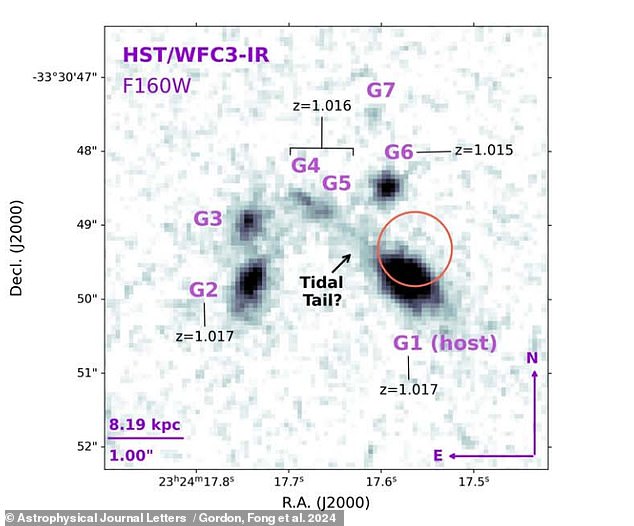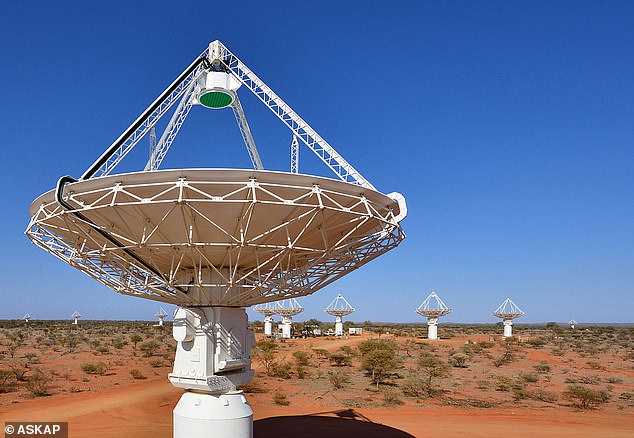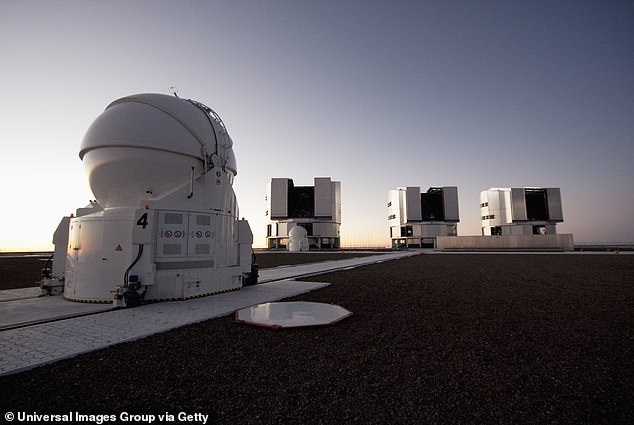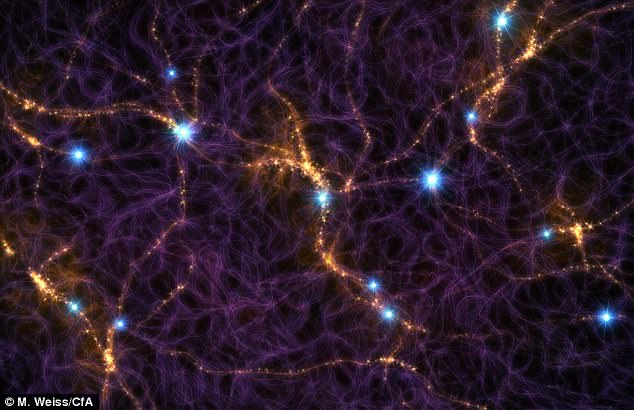Are aliens trying to make contact with Earth? Scientists reveal ‘weird’ origin of signal that has traveled through space for 8 billion years
Scientists have discovered the ‘weird’ origins of a high-energy burst of radio waves that traveled through space for eight billion years before reaching Earth.
The signal, also known as a fast radio burst (FRB), is one of hundreds of volatile energy bursts detected over the years that some astronomers have speculated could be alien life trying to make contact with our planet.
Although scientists do not know the possible mechanism behind this extraordinary phenomenon, they have discovered that the FRB came from a cluster of galaxies that existed when the universe was only five billion years old.
Using NASA’s Hubble Telescope, the team peered into deep space and captured a clear image of the densely packed galaxies.
New images from the NASA Hubble Space Telescope have provided the brightest images yet of the host galaxy of an exceptionally powerful fast radio burst, FRB 20220610A. Hubble’s sensitivity and sharpness revealed this distant galaxy is part of a ‘weird’ cluster of seven galaxies
The FRB, named FRB 20220610A, turned out to be the most powerful and farthest ever detected when astronomers intercepted it in 2022.
However, researchers have since been baffled as to the origins of the burst of energy.
Now the team has identified seven densely packed galaxies as home to the FRB.
“No one has ever been seen in such a compact group,” said astronomer Yuxin (Vic) Dong, who worked on the Northwestern University team studying the strange origins of FRB 20220610A.
“The place of birth is really rare,” she said.
Alexa Gordonwho led the new study at Northwestern, agreed, adding, “It’s these types of environments, these strange ones, that push us to better understand the mystery of FRBs.”
FRBs from densely packed galaxy systems like these could help scientists test two of the main theories about what causes these high-energy radio bursts.
As astronomer Brian Lacki argued in Cambridge International Journal of Astrobiologysuch densely packed systems could jump between planets more easily, making them perfect breeding grounds for a growing alien civilization.

Astronomer Wen-fai Dong, who studies FRB 20220610A, noted that the new Hubble images appear to show elongated shapes or “tidal stories” for some of these galaxies – indicating they may have had collisions. These collisions may have caused this fast radio burst
The origin of FRB 20220610A in a dense cluster of galaxies, 4.2 billion years older than Earth and only 5 billion years older than the Big Bang itself, would mean that any advanced aliens would have a dramatic head start in setting up their own SETI radio.
But this dense cluster of galaxies could one day prove an alternative theory instead: that FRBs are produced by the explosive collisions of neutron stars and other celestial bodies.
Prior to Hubble’s image, which was published earlier this year, astrophysicists and astronomers were unclear as to whether or not the source of the outburst was one giant, amorphous-shaped galaxy or a collection of smaller galaxies orbiting each other.
“Without the Hubble images, it would still remain a mystery whether this FRB comes from a single monolithic galaxy or some kind of interactive system,” as Gordon put it in an article. NASA statement.
According to Gordon, collisions and other interactions between celestial bodies in these seven galaxies can lead to extreme star formations.
In other words, chaotic activity in this busy cluster of galaxies could mean that this strangely powerful, distant FRB is energy launched by the brightening of newborn stars.
Northwestern astronomer Wen-fai Fong, who also worked on the project, noted that the new Hubble images appear to show elongated shapes or “tidal stories” following some of these seven galaxies, suggesting they may have had collisions.
“There are some signs that the group members are ‘interacting,'” Fong said.
“In other words, they could be trading materials or possibly on their way to merge.”

The discovery of this FRB 20220610A, the most distant and therefore oldest known, was made in June 2022 by the ASKAP radio telescope in Australia (above)

FRB 20220610A was confirmed using the European Southern Observatory (ESO) Very Large Telescope (photo)
The first discovery of FRB 20220610A was made in June 2022 by the ASKAP radio telescope in Australia. This was later confirmed using the European Southern Observatory’s (ESO) Very Large Telescope (VLT).
It broke the research team’s previous distance record by 50 percent.
“Using ASKAP’s array of dishes, we were able to determine exactly where the eruption came from,” said astronomer Dr. Stuart Ryder, an adjunct fellow at Macquarie University in Australia, whose team first identified the eruption in 2022.
Astronomers and astrophysicists hope that these kinds of distant FRBs — even if none of them turn out to be coded alien messages — could help find hard-to-see trails of gas clouds and other hidden matter deep in space.
This concept originated with the late Australian astronomer Jean-Pierre (‘JP’) Macquart in 2020, who proposed a method to use FRBs to accurately measure the missing matter in the universe.
“JP showed that the further away a fast radio burst is, the more diffuse gas is released between the galaxies,” says Ryder, “now known as ‘the Macquart relation.’
The team at Northwestern is exploring this possible use of the new data from FRB 20220610A and also the strange, distant galaxy it comes from.
“Radio waves are especially sensitive to material along the line of sight – from the FRB location to us,” Fong noted. “That means the waves must travel through every cloud of material around the FRB site, through the host galaxy, through the universe and ultimately through the Milky Way.”
“From a time delay in the FRB signal itself,” she said, “we can measure the sum of all these contributions.”

